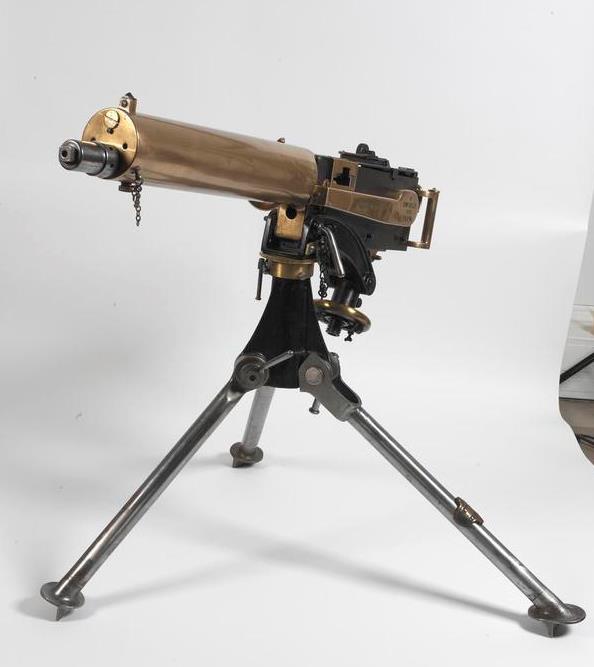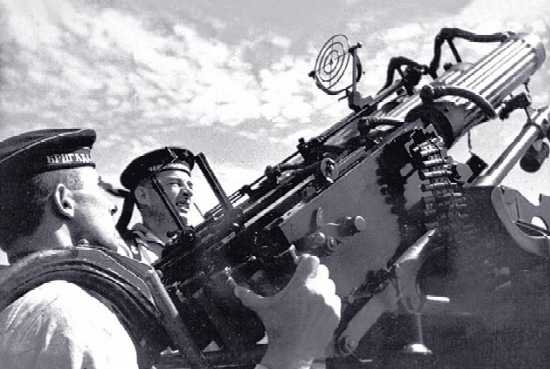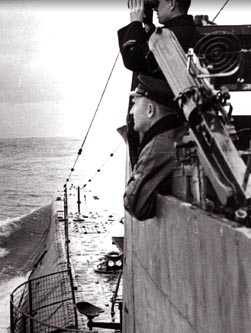
Hiram S. Maxim, an American living in Britain, invented this weapon in 1884. By the early 1890s it had become the standard machine gun of the British Army and was later adopted by the Royal Navy. This was the first truly "automatic" weapon in the world, as firing this gun required no manual operation other than pulling the trigger.
The Maxim system of operation used the energy from the recoiling barrel to work the breech mechanisms. The breech was kept safely locked at the moment of firing, after which the rearward motion of the barrel caused a toggle mechanism to unlock it and permit the action to cycle, ejecting the spent cartridge and loading another from the belt by which the gun was fed. Initially British Maxim Guns employed the 0.450" (11.4 mm) Martini-Henry cartridge, but from 1891 onwards they were chambered for the recently adopted 0.303" (7.7 mm) rifle cartridge.
Along with many other countries, Russia bought samples of the Maxim in the late 19th century and the Russian Navy adopted it during the Russo-Japanese War, using it extensively for the next half-century. Prior to World War II it was the main light AA weapon of the Soviet Navy. During World War II the Soviet Navy used it in single, twin and quad mountings. As did most nations, the Soviets quickly discovered that rifle-caliber guns were ineffective against modern aircraft and the Maxim was replaced by the heavier 12.7 mm (0.50") DShK MG on most ships. However, the Maxim was still widely used to arm small and auxiliary ships.
This machine gun was recoil operated, usually water-cooled and used 250-round belts.
The data that follows is specifically for the Russian version except where noted.
| Designation | Britain: 0.303" (7.7 mm) Maxim MG Mark I Russia: 7.62 mm (0.3") Maxim MG |
|---|---|
| Ship Class Used On | Britain: Most warships from 1890 to 1930 Russian/Soviet: Most warships from 1905 to 1945 |
| Date Of Design | 1884 |
| Date In Service | Britain: 1888 Russian Navy: 1905 |
| Gun Weight | 58.4 lbs. (26.5 kg) |
| Gun Length oa | 43.6 in (1.107 m) |
| Barrel Length | 28.4 in (0.720 m) |
| Rifling Length | N/A |
| Grooves | 4 |
| Lands | N/A |
| Twist | N/A |
| Chamber Volume | N/A |
| Rate Of Fire | Britain (1890): 500 rounds per minute cyclic Russian (1930): 520 - 580 rounds per minute cyclic |
| Type | Fixed |
|---|---|
| Weight of Complete Round | Britain 1890: 0.96 oz (44 gm) |
| Projectile Types and Weights | Britain 1890: 0.5 oz (14 gm) Russia M1930: 0.4 oz (12 gm) |
| Bursting Charge | None: Solid Bullet |
| Projectile Length | N/A |
| Propellant Charge | 0.11 oz (3 gm) |
| Muzzle Velocity | Britain (1890): 2,000 fps (610 mps) Russia (World War II): 2,830 fps (862 mps) |
| Working Pressure | N/A |
| Approximate Barrel Life | N/A |
| Ammunition stowage per gun | British ships of World War I generally carried 5,000 to 8,000 rounds per gun |
| Elevation | Distance |
|---|---|
| Max. Effective Range | 1,090 yards (1,000 m) |
| Max. Range | 2,950 feet (2,400m) |
| AA Ceiling | 500 feet (150 m) |
| Designation |
|
|---|---|
| Weight | British: 160 lbs. (72.6 kg) Russian: N/A |
| Elevation | British: -47 / +20 degrees Russian: N/A |
| Elevation Rate | Manual operation only |
| Train | 360 degrees |
| Train Rate | Manual operation only |
| Gun recoil | N/A |
Data from:
- "Big Gun Monitors: The History of the Design, Construction and Operation of the Royal Navy's Monitors" by Ian Buxton
- "Warship 1990" article by Keith McBride
- "Rapid Fire" by Anthony G. Williams
Other:
- http://www.koreanwaronline.com/arms/mghvruss.htm
- "Flot vo Slavu Rossii" (Fleet in honor of Russia) CD
Special help from Vladimir Yakubov
- 21 May 2006
- Benchmark
- 12 February 2012
- Updated to latest template
- 05 January 2014
- Added information on original design and photograph of British Maxim gun


